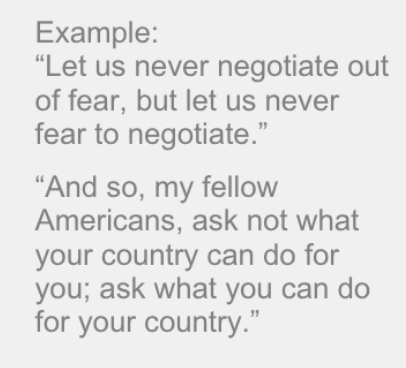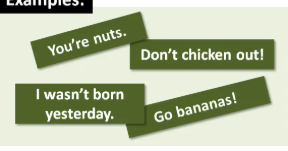Paper 1 - Terminology
1/122
Earn XP
Description and Tags
Flashcards of all of the terminology discussed in the lecture notes to help prepare for the upcoming exam
Name | Mastery | Learn | Test | Matching | Spaced |
|---|
No study sessions yet.
123 Terms
Pronoun
A word that can function by itself as a noun phrase and that refers either to the participants in the discourse or to someone or something mentioned in the discourse
Proper Noun
A noun used to denote a particular person, place, or thing
Common Noun
A noun denoting a class of objects or a concept as opposed to a particular individual
Abstract Noun
A noun denoting an idea, quality, or state rather than a concrete object
Verb
A word used to describe an action, state, or occurrence
Auxiliary Verb
A verb used in forming the tenses, moods, and voices of other verbs
Imperative Verb
Giving an authoritative command
Modal Verb
Expressing possibility
Rhetorical Question
A question asked in order to create a dramatic effect or to make a point rather than to get an answer
Hypophora
A figure of speech in which a writer raises a question and then immediately provides an answer to it
Modifier
A word or phrase used to attribute a quality to another thing
Intensifier
A word or phrase that magnifies the importance of the word it modifies
Superlative
Of the highest quality or degree
Metaphor
A figure of speech in which a word or phrase is applied to an object or action to which it is not literally applicable
Repetition
The action of repeating something that has already been said or written
Tautology
The saying of the same thing twice in different words, generally considered to be a fault of style
Simile
A figure of speech involving the comparison of one thing with another thing of a different kind, used to make a description more emphatic or vivid
Oxymoron
A figure of speech in which apparently contradictory terms appear in conjunctions
Juxtaposition
The fact of two things being seen or placed close together with contrasting effect
Contrast
The state of being strikingly different from something else in juxtaposition or close association
Euphemism
A mild or indirect word or expression substituted for one considered to be too harsh or blunt when referring to something unpleasant or embarrassing
Hyperbole
Exaggerated statements or claims not meant to be taken literally

Synecdoche
A figure of speech in which a part is made to represent the whole or vice versa

Metonymy
The substitution of the name of an attribute or adjunct for that of the thing meant
Anaphoric Reference
The use of a word referring to or replacing a word used earlier in a sentence, to avoid repetition
Irony
The expression of one's meaning by using language that normally signifies the opposite, typically for humorous or emphatic effect
Paradox
A seemingly absurd or self-contradictory statement or proposition that when investigated or explained may prove to be well founded or true
Antithesis
A person or thing that is the direct opposite of someone or something else

Chiasmus
A rhetorical or literary figure in which words, grammatical constructions, or concepts are repeated in reverse order, in the same or a modified form
Understatement
The presentation of something as being smaller or less good or important than it really is
Anaphora
The use of a word referring to or replacing a word used earlier in a sentence, to avoid repetition
Auditory Imagery
Relating to the sense of hearing
Tactile Imagery
Relating to the sense of touch
Olfactory Imagery
Relating to the sense of smell
Gustatory Imagery
Relating to the sense of taste
Synaesthesia
The production of a sense impression relating to one sense or part of the body by stimulation of another sense or part of the body
Alliteration
The occurrence of the same letter or sound at the beginning of adjacent or closely connected words
Assonance
The repetition of the sound of a vowel or diphthong in nonrhyming stressed syllables near enough to each other for the echo to be discernible
Consonance
The recurrence of similar sounds, especially consonants, in close proximity
Sibilance
The recurrence of sibilant sounds (such as s, sh, z, and c) in words
Euphony
The quality of being pleasing to the ear, especially through a harmonious combination of words
Cacophony
A harsh, discordant mixture of sounds
Onomatopoeia
The formation of a word from a sound associated with what is named
Intertextuality
The relationship between texts, especially literary ones
Declarative Sentence
Making a statement or declaration
Interrogative Sentence
Asking a question
Imperative Sentence
Giving an order
Exclamatory Sentence
Expressing strong emotion
Dialect
A particular form of a language which is peculiar to a specific region or social group
Non-Standard English
The language or dialect spoken by the ordinary people in a particular country or region
Vernacular
The language or dialect spoken by the ordinary people in a particular country or region

Colloquial
Used in or characteristic of familiar and informal conversation
Jargon
Special words or expressions used by a profession or group that are difficult for others to understand
Taboo
Prohibited or restricted by social custom
Euphemism
A mild or indirect word or expression substituted for one considered to be too harsh or blunt when referring to something unpleasant or embarrassing
Slang
A type of language that consists of words and phrases that are regarded as very informal; more common in speech than writing
Anecdote
A short and amusing or interesting story about a real incident or person
Facts and Statistics
Numerical data
Direct Speech
The reporting of speech as it was originally spoken
Indirect Speech
The reporting of speech with changes to tense and pronouns
Paraphrasing
Expressing the meaning of (something written or spoken) using different words, especially to achieve greater clarity
Clause
A unit of grammatical organization next below the sentence in rank and in traditional grammar consisting of a subject and predicate
Ambiguity
The quality of being open to more than one interpretation; inexactness
Ambivalence
The state of having mixed feelings or contradictory ideas about something or someone
Bias
Prejudice in favor of or against one thing, person, or group compared with another, usually in a way considered to be unfair
Caricature
A picture, description, or imitation of a person or thing in which certain striking characteristics are exaggerated in order to create a comic or grotesque effect
Cliché
A phrase or opinion that is overused and betrays a lack of original thought
Contractions
A shortened form of a word or syllable
Hyperbole
The use of exaggeration as a rhetorical device or figure of speech
Formulaic
Consisting of a set form of conventional phrases or language

Deixis
Words and phrases that refer directly to the situational context of an utterance
Pun
A joke exploiting the different possible meanings of a word or the fact that there are words which sound alike but have different meanings
Exophoric Reference
Referring to something beyond the text
Paradox
A seemingly absurd or self-contradictory statement or proposition that when investigated or explained may prove to be well founded or true
Loan Word
A word adopted from a foreign language
Neologism
A newly coined word or expression
Font Size/Colour
The size or appearance of a font
Serif Font
A font with serifs
Script/Handwriting Font
A font that resembles handwriting
Focal Point
The visual element in a design that first captures the viewer's attention
Colour Palette
A set of colors used in a design
Graphology
The study of handwriting
Typography
The style and appearance of printed matter
Emboldened/Italicised/Underlined
Emphasized text
Camera Angle
The position from which a photograph is taken
Subject Matter
The subject matter of an image
Indexical
Related to the overall topic
Contradictory Image
Images that contradict the text
Square with the text
Images that align with the text
Use of Space
How space is used in a design
Multimodal
Involving several forms of communication
Captions
Text accompanying an image
Logo
A symbol or design adopted by an organization
Body Text
The main body of text in a document
Branding
The act of promoting a product or service through the use of a brand
Overlay
A graphic that covers part of the main text or image
Speech/Scream/Broadcast/Thought/Whisper Bubble
Visual representations of speech
Action Words
Words that describe actions
Left to Right Placement
The arrangement of elements from left to right
Top to Bottom Placement
The arrangement of elements from top to bottom